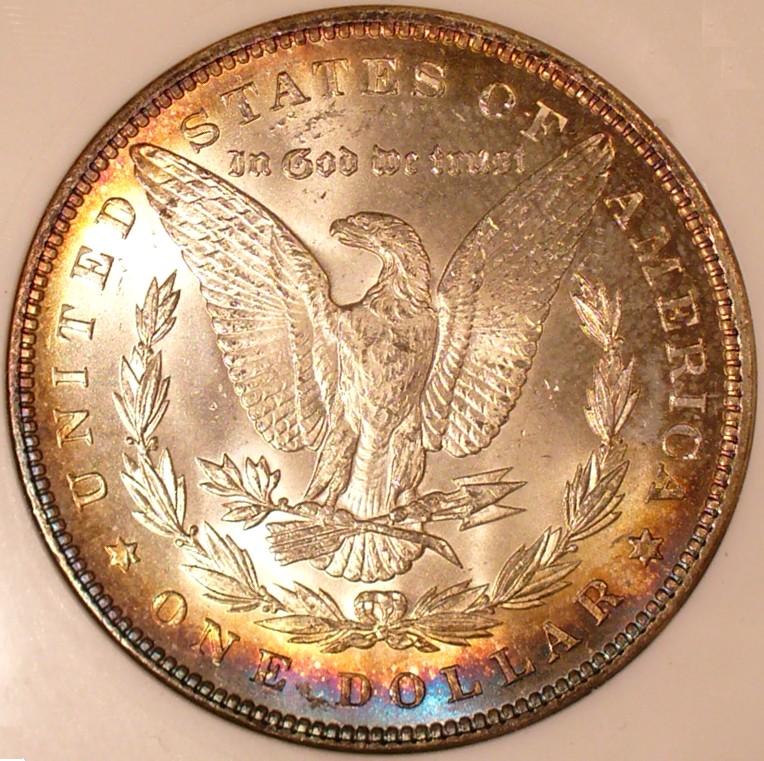Toning (coin) on:
[Wikipedia]
[Google]
[Amazon]
 Toning on a
Toning on a
 Toning on a
Toning on a coin
A coin is a small, flat (usually depending on the country or value), round piece of metal or plastic used primarily as a medium of exchange or legal tender. They are standardized in weight, and produced in large quantities at a mint in order ...
is the change of colour brought about through oxidization, which forms a thin layer of tarnish
Tarnish is a thin layer of corrosion that forms over copper, brass, aluminum, magnesium, neodymium and other similar metals as their outermost layer undergoes a chemical reaction. Tarnish does not always result from the sole effects of oxygen in ...
on the metal's surface. Coin toning can vary in aesthetics
Aesthetics, or esthetics, is a branch of philosophy that deals with the nature of beauty and taste, as well as the philosophy of art (its own area of philosophy that comes out of aesthetics). It examines aesthetic values, often expressed t ...
, and thus can alternately add or detract from a coin's value. Coins with unusual toning colours or patterns tend to be valued by coin collectors
Coin collecting is the collecting of coins or other forms of minted legal tender.
Coins of interest to collectors often include those that were in circulation for only a brief time, coins with mint errors, and especially beautiful or historic ...
. Toning is most common on silver coins, but can be found on coins minted from other metals and alloys, including gold, copper and cupronickel
Cupronickel or copper-nickel (CuNi) is an alloy of copper that contains nickel and strengthening elements, such as iron and manganese. The copper content typically varies from 60 to 90 percent. ( Monel is a nickel-copper alloy that contains a mi ...
.
Types of toning
Different colors and patterns of toning can have varying effects on a coin's grade and value. For example, brown spotty toning could decrease a coin's value, while colorful rainbow toning could increase it. Similarly, toning can raise or lower a coin'sgrade
Grade most commonly refers to:
* Grade (education), a measurement of a student's performance
* Grade, the number of the year a student has reached in a given educational stage
* Grade (slope), the steepness of a slope
Grade or grading may also ref ...
by several points, as grading is based on factors including eye appeal and not just wear. Depending on the environment in which the toning took place, toned coins can come in many different colors and color combinations. Toning patterns may cover an entire coin, just one side, or just one area. Coins which have sat stacked in bags for a long time can develop crescent toning, where the toned coin was partially covered by one sitting off-center on top of it. This is common with Morgan dollar
The Morgan dollar is a United States dollar coin minted from 1878 to 1904, in 1921, and beginning again in 2021. It was the first standard silver dollar minted since the passage of the Coinage Act of 1873, which ended the free coining of silve ...
s, which were typically delivered to and stored in banks in large cloth bags.
Artificial toning
Coins are sometimes toned artificially through the use of chemicals or heat. This may be done by those seeking to increase their value, but unnatural toning on rare coins will reduce their value when detected. Coins with original surfaces are almost always preferable, although coins with extreme artificial toning, such as alteredAmerican Silver Eagle
The American Silver Eagle is the official silver bullion coin of the United States.
It was first released by the United States Mint on November 24, 1986. It is struck only in the one- troy ounce, which has a nominal face value of one dollar ...
s, are sometimes sold as novelties.
References
{{Portal bar, Numismatics Coins